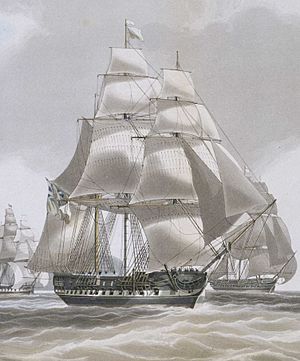HMS Ariadne (1816) facts for kids

Ariadne in July 1830
|
|
Quick facts for kids History |
|
|---|---|
| Name | Ariadne |
| Namesake | Ariadne |
| Ordered | 28 November 1812 |
| Builder | Pater Dockyard |
| Laid down | April 1815 |
| Launched | 10 February 1816 |
| Completed | 21 March 1816 |
| Commissioned | April 1823 |
| Reclassified | As a coal hulk, 1836–1837 |
| Fate | Sold for scrap, 12 July 1841 |
| General characteristics | |
| Class and type | Hermes-class post ship |
| Tons burthen | 509 25⁄94 bm |
| Length |
|
| Beam | 31 ft (9.4 m) |
| Draught | 10 ft 3 in (3.1 m) |
| Depth | 8 ft 8 in (2.6 m) |
| Sail plan | Full-rigged ship |
| Complement | 135 |
| Armament |
|
HMS Ariadne was a sailing ship built for the Royal Navy (the British navy) in the 1810s. She was a "post ship," which was a type of warship with 20 to 24 guns. Ariadne was finished in 1816 but didn't start active duty until 1823.
She sailed to different parts of the world, including the Cape of Good Hope Station (near South Africa) and the Mediterranean Sea. Later, she served in the North America and West Indies Station (around North America and the Caribbean) from 1829 to 1835. After her service, she became a "coal hulk" (a ship used to store coal) and was eventually sold for scrap in 1841.
Contents
Ship's Design and Size
Ariadne was a medium-sized sailing warship. Her main deck, called the gundeck, was about 37 meters (121 feet 7 inches) long. The bottom of her hull, known as the keel, was about 30.6 meters (100 feet 6 inches) long.
The ship was about 9.4 meters (30 feet 11 inches) wide. Her draught (how deep she sat in the water) was about 3 meters (10 feet). The hold (the space inside the ship for cargo) was about 2.6 meters (8 feet 9 inches) deep.
Ship's Armament
Ariadne was armed with many guns. At first, she had eighteen 32-pounder carronades on her gundeck. Carronades were short, powerful cannons used for close-range fighting. She also had two 9-pounder cannons as chase guns, which could fire forwards or backwards.
Later, after 1820, she was updated to carry 26 guns. This included eighteen 32-pounder carronades on the gundeck. She also had six 18-pounder carronades on the quarterdeck and two 9-pounder bow chasers on the forecastle. The ship needed a crew of 135 sailors and officers to operate.
Building and Service History
Ariadne was the third ship in the Royal Navy to carry this name. She was ordered on November 28, 1812. Her construction began in April 1815 at Pater Dockyard in Wales.
Launch and Early Years
Ariadne was launched into the water on February 10, 1816. Her sister ship, Valorous, was launched on the same day. Building Ariadne cost about £11,936, and getting her ready for sea cost another £3,579.
After being built, she was kept "in ordinary," meaning she was stored and not actively used. In 1820, she was changed into a 26-gun ship at Plymouth Dockyard. This involved adding a quarterdeck and forecastle. She was then fully prepared for sea duty in 1822.
Active Service and Travels
Ariadne began her first active duty in April 1823 under Captain Robert Moorsom. In December 1824, Captain Isaac Chapman took command. The ship was then sent to the Cape of Good Hope Station.
In February 1826, Captain Lord Adolphus Fitzclarence took over command. By this time, Ariadne was part of the Mediterranean Fleet. She finished this service in May 1828 and returned to Plymouth.
After a period of repairs, Captain Frederick Marryat became her commander in October 1828. She then sailed to the Central Atlantic. Ariadne finished this duty in November 1830. She was then recommissioned for service in the North America and West Indies Station, where she served until 1835.
Final Years
In November 1836, Ariadne was converted into a coal hulk. This meant she was used to store coal for other ships. She served in this role at Alexandria, Egypt. Finally, on July 23, 1841, Ariadne was sold for scrap.

